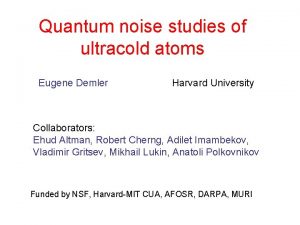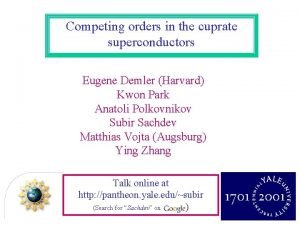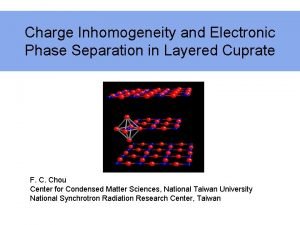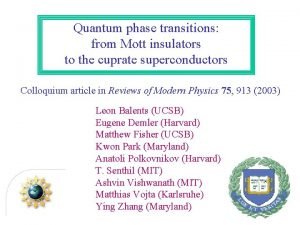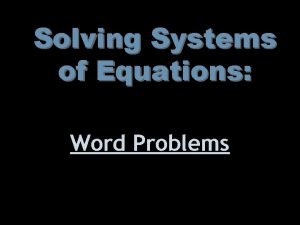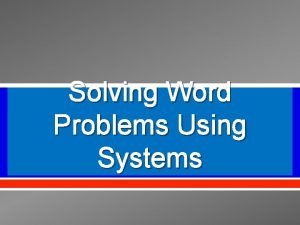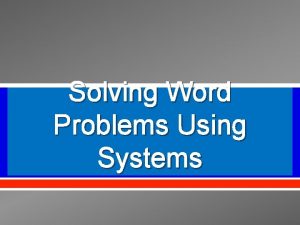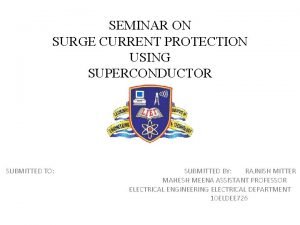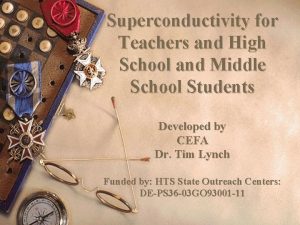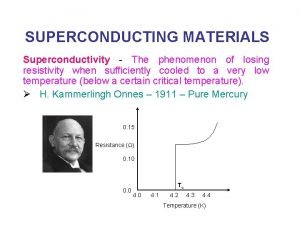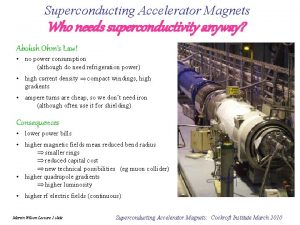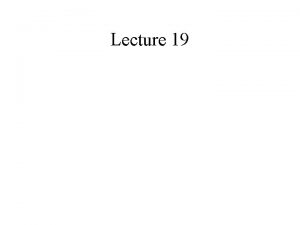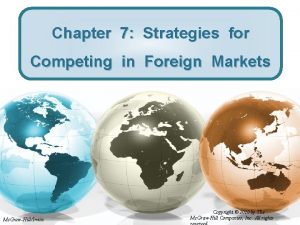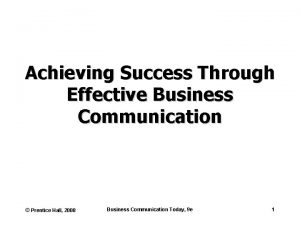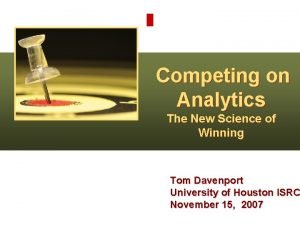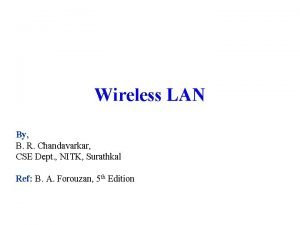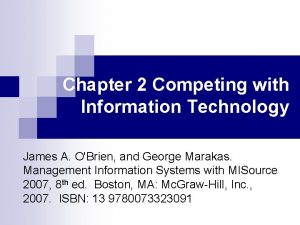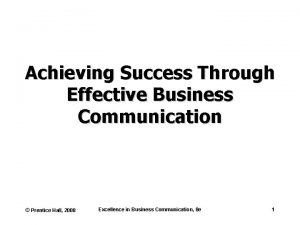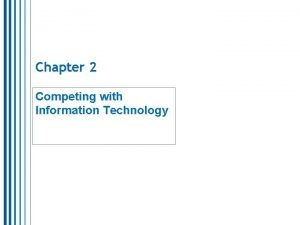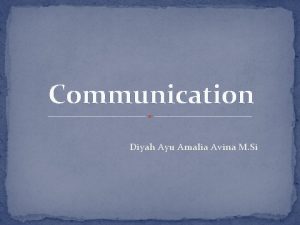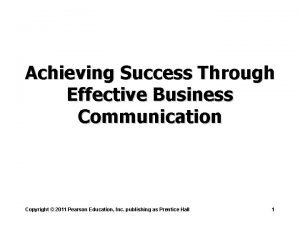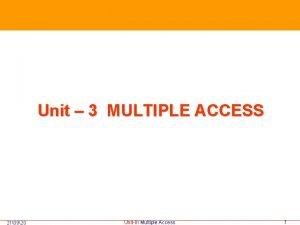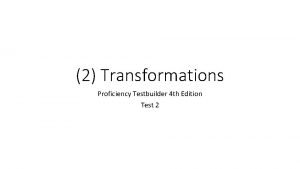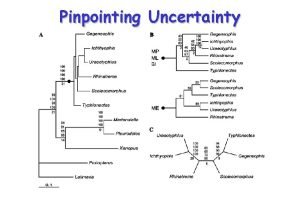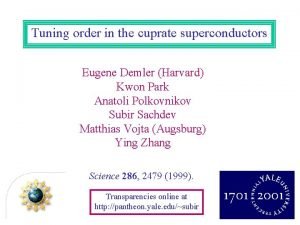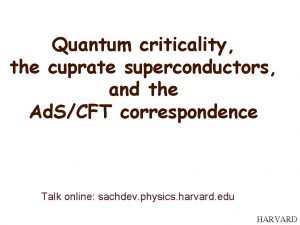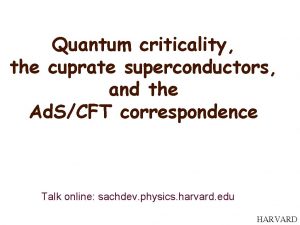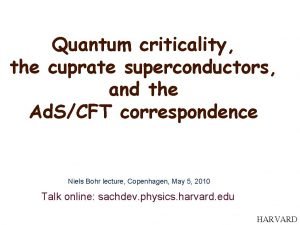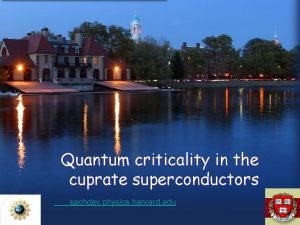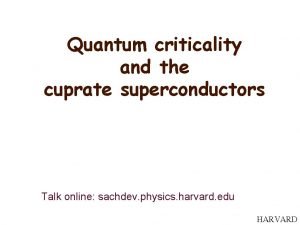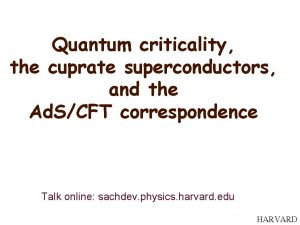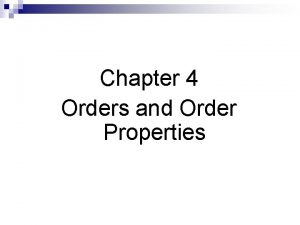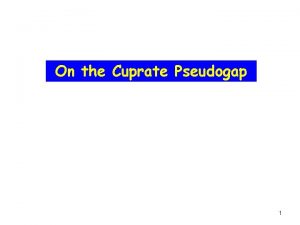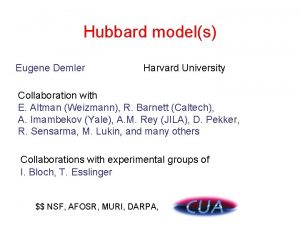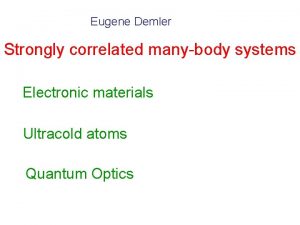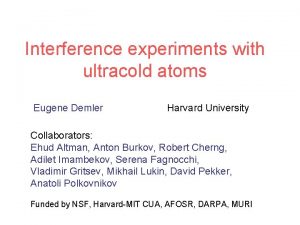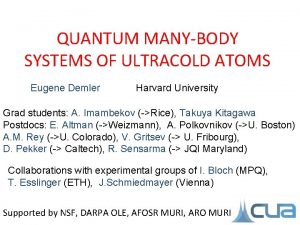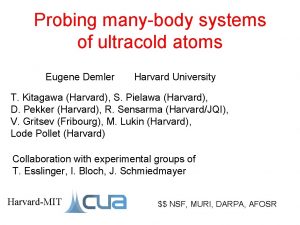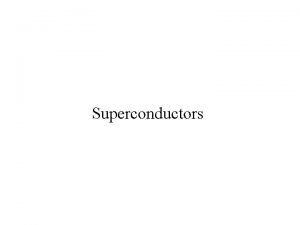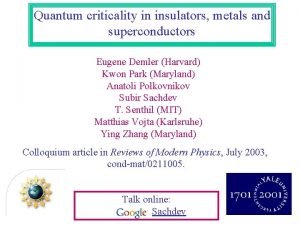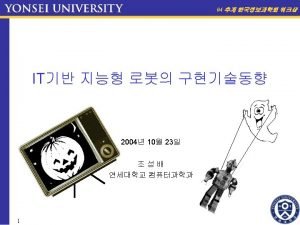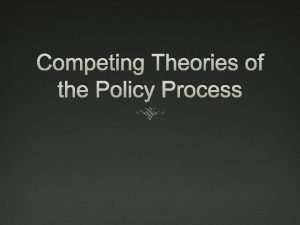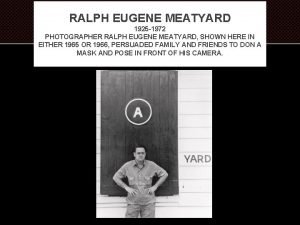Competing orders in the cuprate superconductors Eugene Demler

































- Slides: 33

Competing orders in the cuprate superconductors Eugene Demler (Harvard) Kwon Park Anatoli Polkovnikov Subir Sachdev Matthias Vojta (Augsburg) Ying Zhang Talk online at http: //pantheon. yale. edu/~subir (Search for “Sachdev” on )


Superconductivity in a doped Mott insulator Hypothesis: cuprate superconductors have low energy excitations associated with additional order parameters Theory and experiments indicate that the most likely candidates are spin density waves and associated “charge” order Superconductivity can be suppressed globally by a strong magnetic field or large current flow. Competing orders are also revealed when superconductivity is suppressed locally, near impurities or around vortices. S. Sachdev, Phys. Rev. B 45, 389 (1992); N. Nagaosa and P. A. Lee, Phys. Rev. B 45, 966 (1992); D. P. Arovas, A. J. Berlinsky, C. Kallin, and S. -C. Zhang Phys. Rev. Lett. 79, 2871 (1997); K. Park and S. Sachdev Phys. Rev. B 64, 184510 (2001).

Outline I. Experimental introduction II. Spin density waves (SDW) in LSCO Tuning order and transitions by a magnetic field. III. Connection with “charge” order – phenomenological theory STM experiments on Bi 2 Sr 2 Ca. Cu 2 O 8+d IV. Connection with “charge” order – microscopic theory Theories of magnetic transitions predict bond-centered modulation of exchange and pairing energies with even periods---a bond order wave V. Conclusions

I. Experimental introduction The doped cuprates 2 -D Cu. O 2 plane with ground finite hole Néel ordered statedoping at zero doping

Phase diagram of the doped cuprates T 3 D AFM 0 d-wave SC

T = 0 phases of LSCO ky /a 0 Superconductor Insulator with Tc, min =20 K • • • • • • /a Néel SDW 0 0. 02 0. 055 kx SC SC+SDW ~0. 12 -0. 14 S. Wakimoto, G. Shirane et al. , Phys. Rev. B 60, R 769 (1999). G. Aeppli, T. E. Mason, S. M. Hayden, H. A. Mook, J. Kulda, Science 278, 1432 (1997). Y. S. Lee, R. J. Birgeneau, M. A. Kastner et al. , Phys. Rev. B 60, 3643 (1999).

SDW order parameter for general ordering wavevector Bond-centered Site-centered

II. Effect of a magnetic field on SDW order with co-existing superconductivity H ky /a 0 Superconductor • • Insulator • • with Tc, min =20 K • /a Néel SDW 0 0. 02 0. 055 kx SC+SDW SC ~0. 12

H SDW Spin singlet state dc d Characteristic field gm. BH = D, the spin gap 1 Tesla = 0. 116 me. V Effect is negligible over experimental field scales

Dominant effect: uniform softening of spin excitations by superflow kinetic energy Competing order is enhanced in a “halo” around each vortex E. Demler, S. Sachdev, and Y. Zhang, Phys. Rev. Lett. 87, 067202 (2001).

Effect of magnetic field on SDW+SC to SC transition (extreme Type II superconductivity) Infinite diamagnetic susceptibility of non-critical superconductivity leads to a strong effect. • Theory should account for dynamic quantum spin fluctuations • All effects are ~ H 2 except those associated with H induced superflow. • Can treat SC order in a static Ginzburg-Landau theory

Main results T=0 dc d E. Demler, S. Sachdev, and Y. Zhang, Phys. Rev. Lett. 87, 067202 (2001).

Neutron scattering measurements of static spin correlations of the superconductor+spin-density-wave (SC+SDW) in a magnetic field

B. Lake, H. M. Rønnow, N. B. Christensen, G. Aeppli, K. Lefmann, D. F. Mc. Morrow, P. Vorderwisch, P. Smeibidl, N. Mangkorntong, T. Sasagawa, M. Nohara, H. Takagi, T. E. Mason, Nature, 415, 299 (2002).

III. Connections with “charge” order – phenomenological theory Spin density wave order parameter for general ordering wavevector Bond-centered Site-centered

A longitudinal spin density wave necessarily has an accompanying modulation in the site charge densities, exchange and pairing energy per link etc. at half the wavelength of the SDW “Charge” order: periodic modulation in local observables invariant under spin rotations and time-reversal. Order parmeter J. Zaanen and O. Gunnarsson, Phys. Rev. B 40, 7391 (1989). H. Schulz, J. de Physique 50, 2833 (1989). K. Machida, Physica 158 C, 192 (1989). O. Zachar, S. A. Kivelson, and V. J. Emery, Phys. Rev. B 57, 1422 (1998). Prediction: Charge order should be pinned in halo around vortex core K. Park and S. Sachdev Phys. Rev. B 64, 184510 (2001). E. Demler, S. Sachdev, and Ying Zhang, Phys. Rev. Lett. 87, 067202 (2001).

STM around vortices induced by a magnetic field in the superconducting state J. E. Hoffman, E. W. Hudson, K. M. Lang, V. Madhavan, S. H. Pan, H. Eisaki, S. Uchida, and J. C. Davis, Science 295, 466 (2002). Local density of states 1Å spatial resolution image of integrated LDOS of Bi 2 Sr 2 Ca. Cu 2 O 8+d ( 1 me. V to 12 me. V) at B=5 Tesla. S. H. Pan et al. Phys. Rev. Lett. 85, 1536 (2000).

Vortex-induced LDOS of Bi 2 Sr 2 Ca. Cu 2 O 8+d integrated from 1 me. V to 12 me. V 7 p. A b 0 p. A 100Å J. Hoffman E. W. Hudson, K. M. Lang, V. Madhavan, S. H. Pan, H. Eisaki, S. Uchida, and J. C. Davis, Science 295, 466 (2002).

Fourier Transform of Vortex-Induced LDOS map K-space locations of vortex induced LDOS K-space locations of Bi and Cu atoms Distances in k –space have units of 2 p/a 0 a 0=3. 83 Å is Cu-Cu distance J. Hoffman et al. Science, 295, 466 (2002).

Summary of theory and experiments (extreme Type II superconductivity) T=0 Neutron scattering observation of SDW order enhanced by superflow. STM observation of CDW fluctuations enhanced by superflow and pinned by vortex cores. dc d E. Demler, S. Sachdev, and Y. Zhang, Phys. Rev. Lett. 87, 067202 (2001). Quantitative connection between the two experiments ?

Pinning of CDW order by vortex cores in SC phase Y. Zhang, E. Demler, and Sachdev, cond-mat/0112343. S.

Vortex-induced LDOS of Bi 2 Sr 2 Ca. Cu 2 O 8+d integrated from 1 me. V to 12 me. V 7 p. A b 0 p. A 100Å J. Hoffman E. W. Hudson, K. M. Lang, V. Madhavan, S. H. Pan, H. Eisaki, S. Uchida, and J. C. Davis, Science 295, 466 (2002).

IV. Microscopic theory of the charge order: magnetic transitions in Mott insulators and superconductors Magnetic transitions in the coupled ladder antiferromagnet: Action for quantum spin fluctuations in spacetime Discretize spacetime into a cubic lattice with Néel order orientation S. Chakravarty, B. I. Halperin, and D. R. Nelson, Phys. Rev. B 39, 2344 (1989). Quantum path integral for two-dimensional quantum antiferromagnet Partition function of a classical three-dimensional ferromagnet at a “temperature” g Missing: Spin Berry Phases (Can be neglected on the coupled ladder, but not on the square lattice) Berry phases profoundly modify paramagnetic states with

Field theory of paramagnetic (“quantum disordered”) phase on the square lattice Discretize spacetime into a cubic lattice: Change in choice of n 0 is like a “gauge transformation” (ga is the oriented area of the spherical triangle formed by na and the two choices for n 0 ). The area of the triangle is uncertain modulo 4 , and the action is invariant under These principles strongly constrain the effective action for Aam

Simplest large g effective action for the Aam This theory can be reliably analyzed by a duality mapping. The gauge theory is always in a confining phase: There is an energy gap and the ground state has a bond order wave. N. Read and S. Sachdev, Phys. Rev. Lett. 62, 1694 (1989). S. Sachdev and R. Jalabert, Mod. Phys. Lett. B 4, 1043 (1990). K. Park and S. Sachdev, Phys. Rev. B 65, 220405 (2002).

IV. Microscopic theory of the charge order: magnetic transitions in Mott insulators and superconductors Bond order wave in a frustrated S=1/2 XY magnet A. W. Sandvik, S. Daul, R. R. P. Singh, and D. J. Scalapino, cond-mat/0205270 First large scale numerical study of the destruction of Neel order in S=1/2 antiferromagnet with full square lattice symmetry g= N. Read and S. Sachdev, Phys. Rev. Lett. 62, 1694 (1989); S. Sachdev and K. Park, Annals of Physics 298, 58 (2002).

IV. Bond order waves in the superconductor. “Large N” theory in region with preserved spin rotation symmetry g Long-range charge order without spin order S. Sachdev and N. Read, Int. J. Mod. Phys. B 5, 219 (1991). M. Vojta and S. Sachdev, Phys. Rev. Lett. 83, 3916 (1999). M. Vojta, Y. Zhang, and S. Sachdev, Phys. Rev. B 62, 6721 (2000). Hatched region --- spin order Shaded region ---- charge order See also J. Zaanen, Physica C 217, 317 (1999), S. Kivelson, E. Fradkin and V. Emery, Nature 393, 550 (1998), S. White and D. Scalapino, Phys. Rev. Lett. 80, 1272 (1998). C. Castellani, C. Di Castro, and M. Grilli, Phys. Rev. Lett. 75, 4650 (1995). S. Mazumdar, R. T. Clay, and D. K. Campbell, Phys. Rev. B 62, 13400 (2000). Charge order is bond-centered and has an even period.

IV. STM image of pinned charge order in Bi 2 Sr 2 Ca. Cu 2 O 8+d in zero magnetic field Charge order period = 4 lattice spacings C. Howald, H. Eisaki, N. Kaneko, and A. Kapitulnik, cond-mat/0201546

Spectral properties of the STM signal are sensitive to the microstructure of the charge order Measured energy dependence of the Fourier component of the density of states which modulates with a period of 4 lattice spacings C. Howald, H. Eisaki, N. Kaneko, and A. Kapitulnik, cond-mat/0201546 Theoretical modeling shows that this spectrum is best obtained by a modulation of bond variables, such as the exchange, kinetic or pairing energies. M. Vojta, cond-mat/0204284. D. Podolsky, E. Demler, K. Damle, and B. I. Halperin, condmat/0204011

IV. Neutron scattering observation of static charge order in YBa 2 Cu 3 O 6. 35 (spin correlations are dynamic) Charge order period = 8 lattice spacings H. A. Mook, Pengcheng Dai, and F. Dogan Phys. Rev. Lett. 88, 097004 (2002).

IV. Bond order waves in the superconductor. “Large N” theory in region with preserved spin rotation symmetry Sachdev and N. Read, Int. J. Mod. Phys. B 5, 219 (1991). M. Vojta and S. Sachdev, Phys. Rev. Lett. 83, 3916 (1999). M. Vojta, Y. Zhang, and S. Sachdev, Phys. Rev. B 62, 6721 (2000). g Hatched region --- spin order Shaded region ---- charge order See also J. Zaanen, Physica C 217, 317 (1999), S. Kivelson, E. Fradkin and V. Emery, Nature 393, 550 (1998), S. White and D. Scalapino, Phys. Rev. Lett. 80, 1272 (1998). C. Castellani, C. Di Castro, and M. Grilli, Phys. Rev. Lett. 75, 4650 (1995). S. Mazumdar, R. T. Clay, and D. K. Campbell, Phys. Rev. B 62, 13400 (2000). S.

Conclusions I. Cuprate superconductivity is associated with doping Mott insulators with charge carriers II. The correct paramagnetic Mott insulator has bond-order and confinement of spinons III. Mott insulator reveals itself vortices and near impurities. Predicted effects seen recently in STM and NMR experiments. IV. Semi-quantitative predictions for neutron scattering measurements of spin-density-wave order in superconductors; theory also establishes connection to STM experiments. V. Future experiments should search for SC+SDW to SC quantum transition driven by a magnetic field. VI. Major open question: how does understanding of low temperature order parameters help explain anomalous behavior at high temperatures ?
 Eugene demler
Eugene demler Eugene demler
Eugene demler Cuprate charge order
Cuprate charge order Cuprate charge order
Cuprate charge order Casey orders 3 pizzas and 2 orders of breadsticks
Casey orders 3 pizzas and 2 orders of breadsticks Casey orders 3 pizzas and 2 orders of breadsticks
Casey orders 3 pizzas and 2 orders of breadsticks Casey orders 3 pizzas
Casey orders 3 pizzas Surge current protection using superconductors
Surge current protection using superconductors Surge current protection using superconductors pdf
Surge current protection using superconductors pdf What are superconductors
What are superconductors Superconductivity
Superconductivity Superconductors
Superconductors Persistent currents
Persistent currents Strategies for competing in international markets
Strategies for competing in international markets Competing messages communication barriers
Competing messages communication barriers Competing with information technology
Competing with information technology Competing with information technology
Competing with information technology Competing messages communication barriers
Competing messages communication barriers Competing on analytics
Competing on analytics Ten thousand airline reservation stations are competing for
Ten thousand airline reservation stations are competing for Competing with information technology
Competing with information technology Achieving success through effective business communication
Achieving success through effective business communication Competing with information technology
Competing with information technology Competing for advantage
Competing for advantage Difinition of communication
Difinition of communication Competing behavior pathway
Competing behavior pathway Competing messages communication barriers
Competing messages communication barriers The competing visions of reconstruction
The competing visions of reconstruction Ten thousand airline reservation stations are competing for
Ten thousand airline reservation stations are competing for Competing shark
Competing shark They still haven't found out what caused the accident
They still haven't found out what caused the accident Competing for colonies
Competing for colonies Analysis of competing hypotheses template
Analysis of competing hypotheses template Competing behavior pathway example
Competing behavior pathway example
